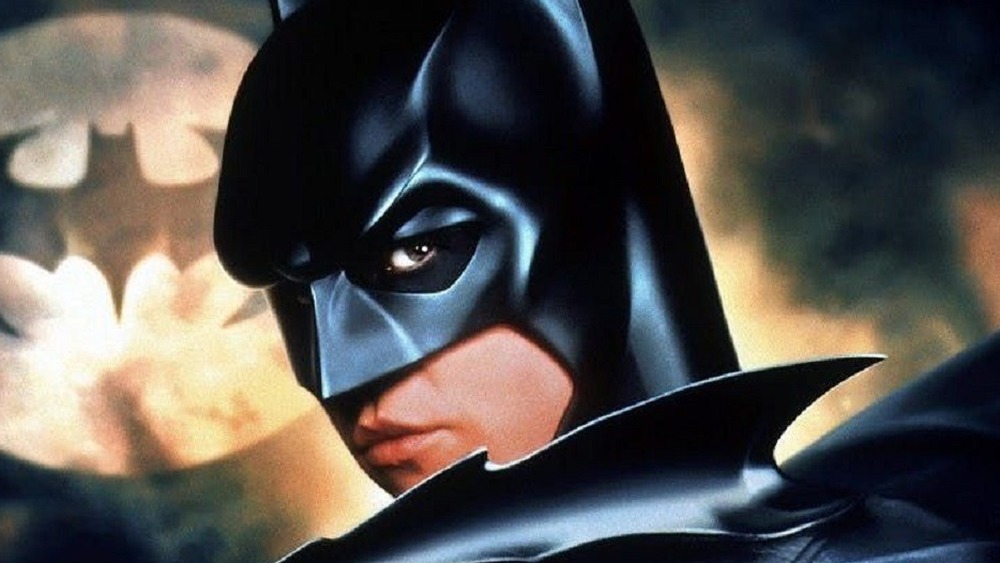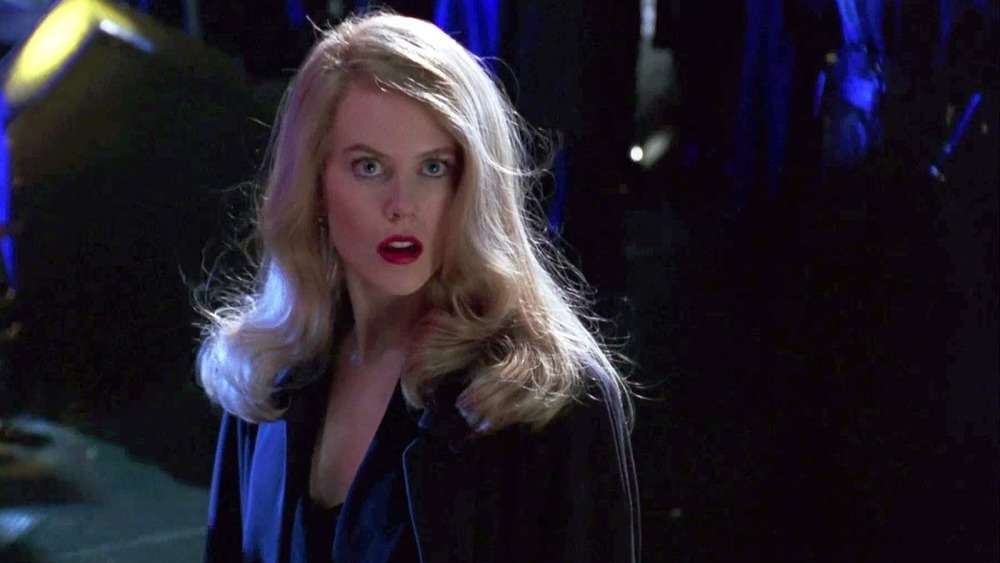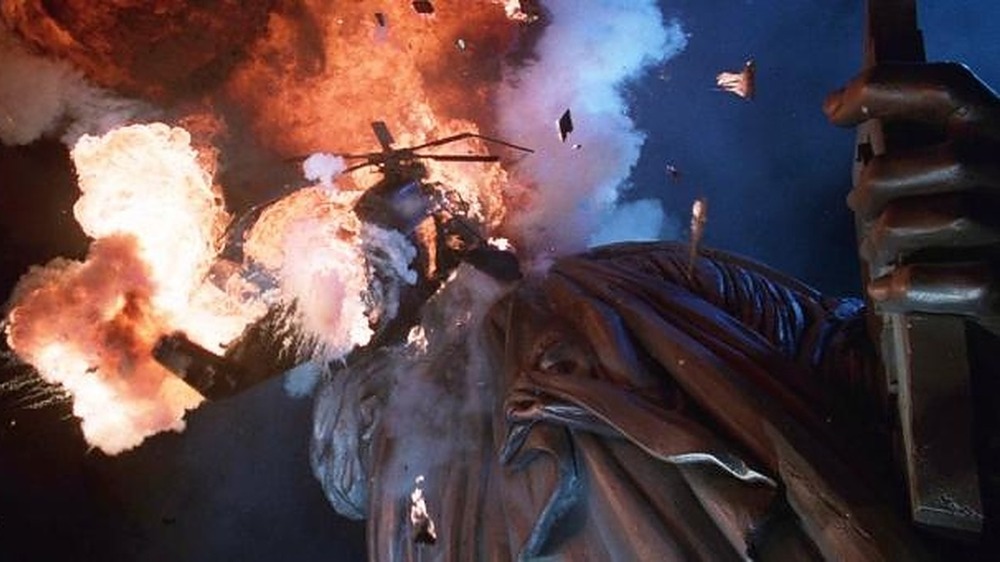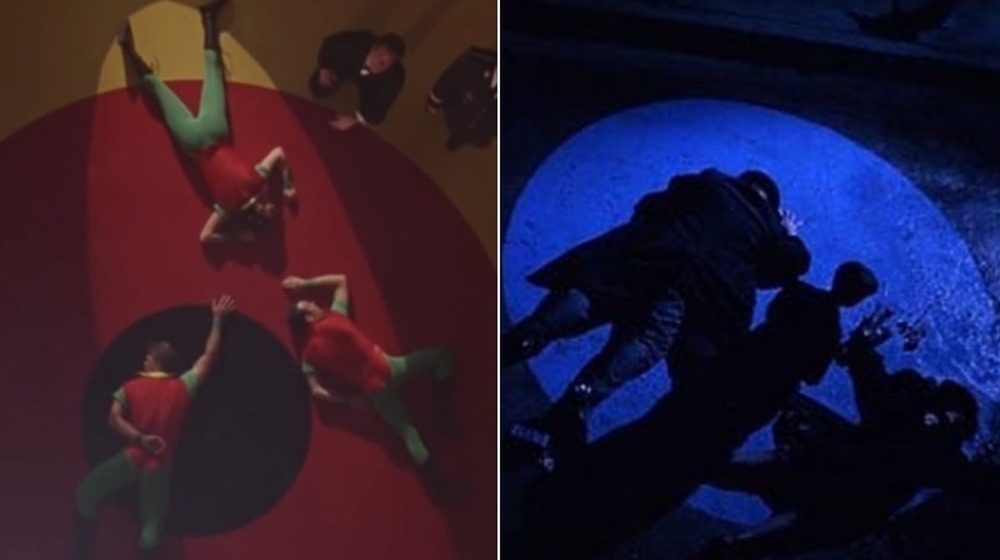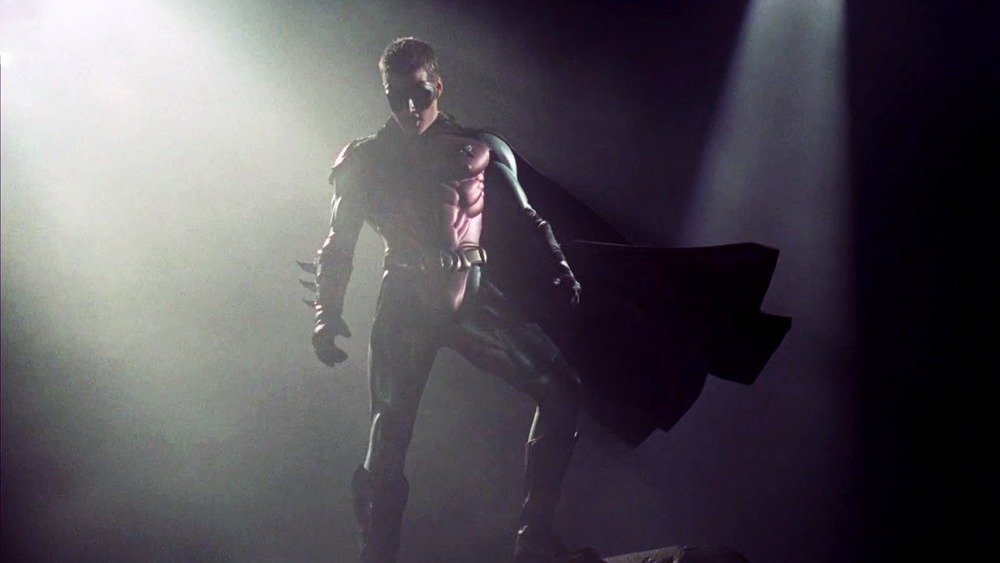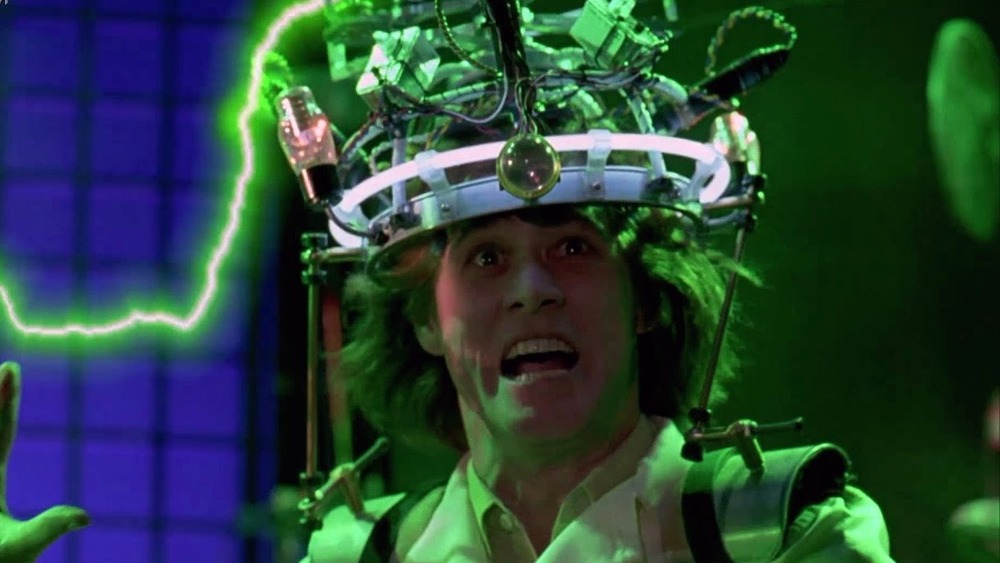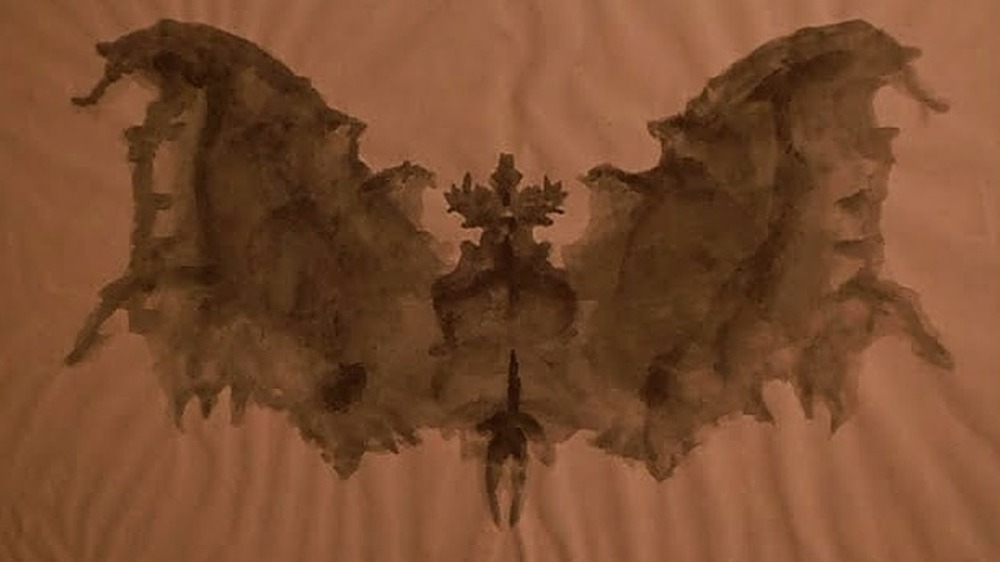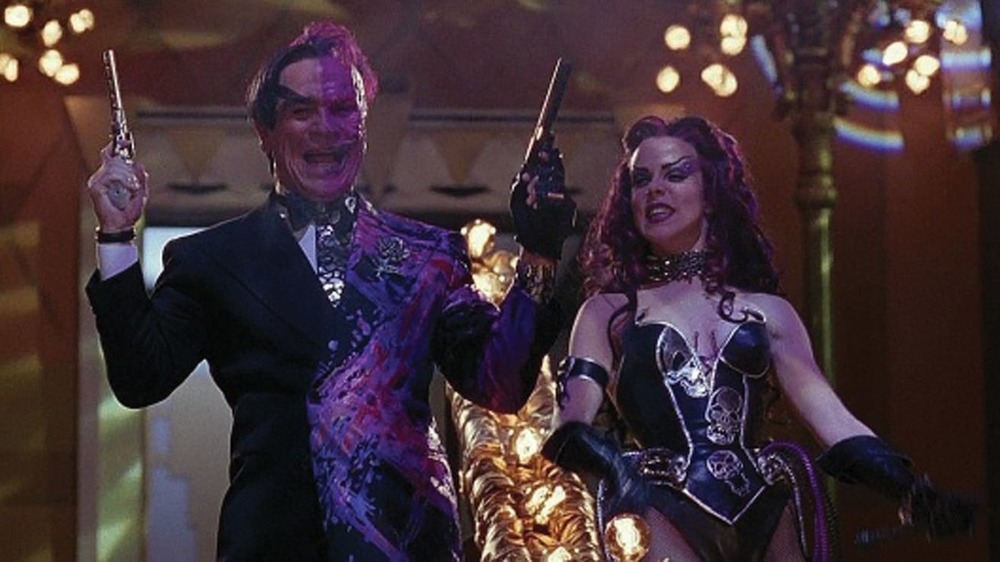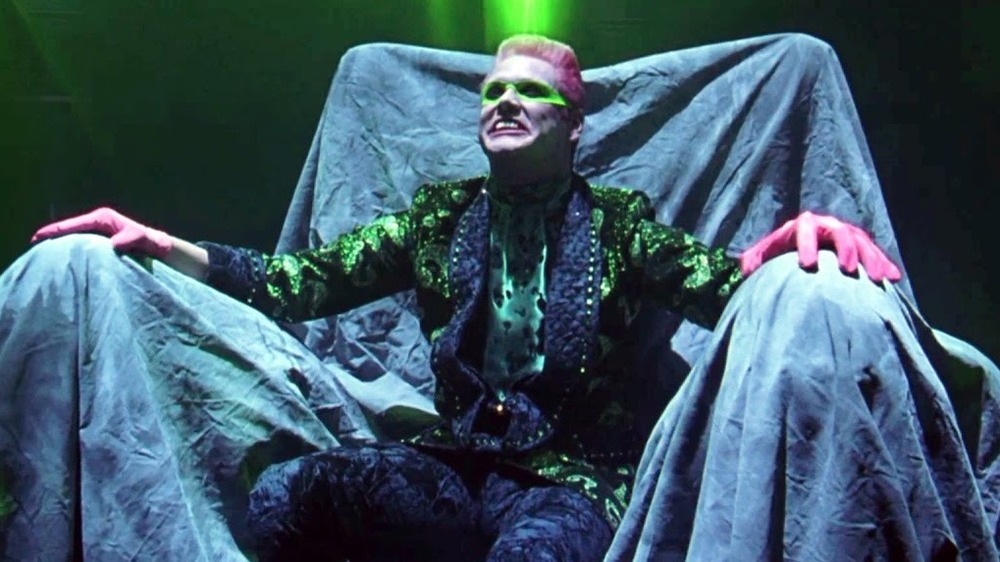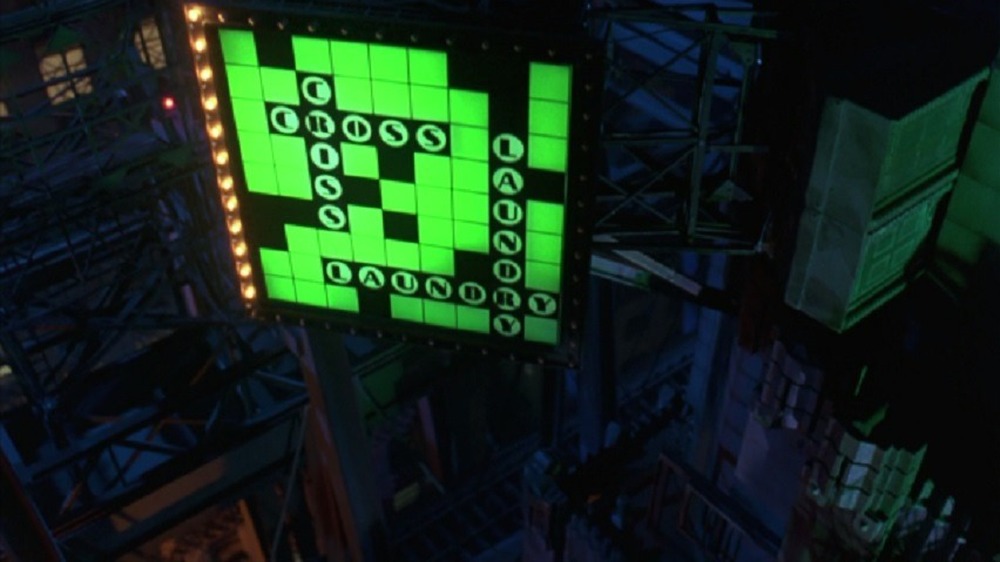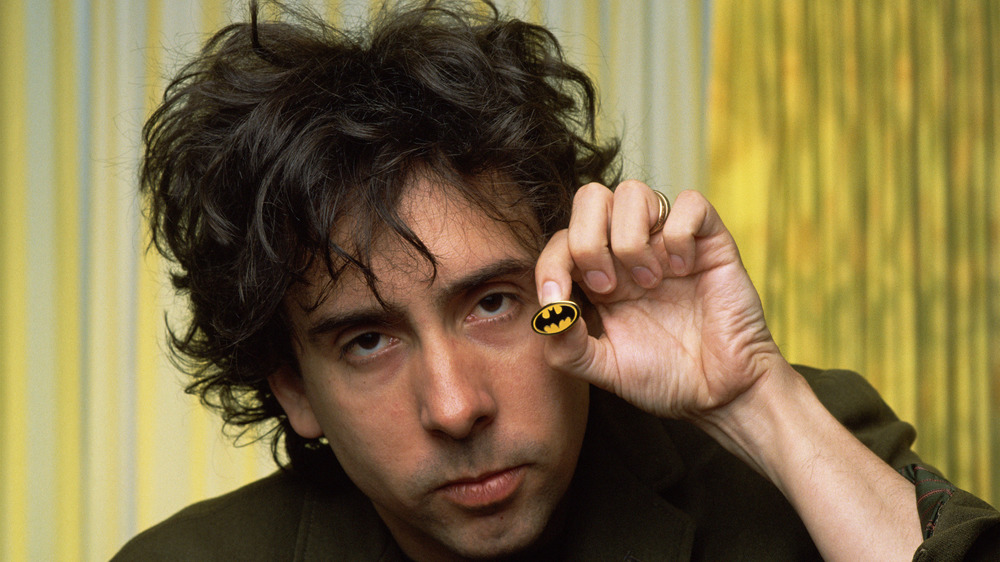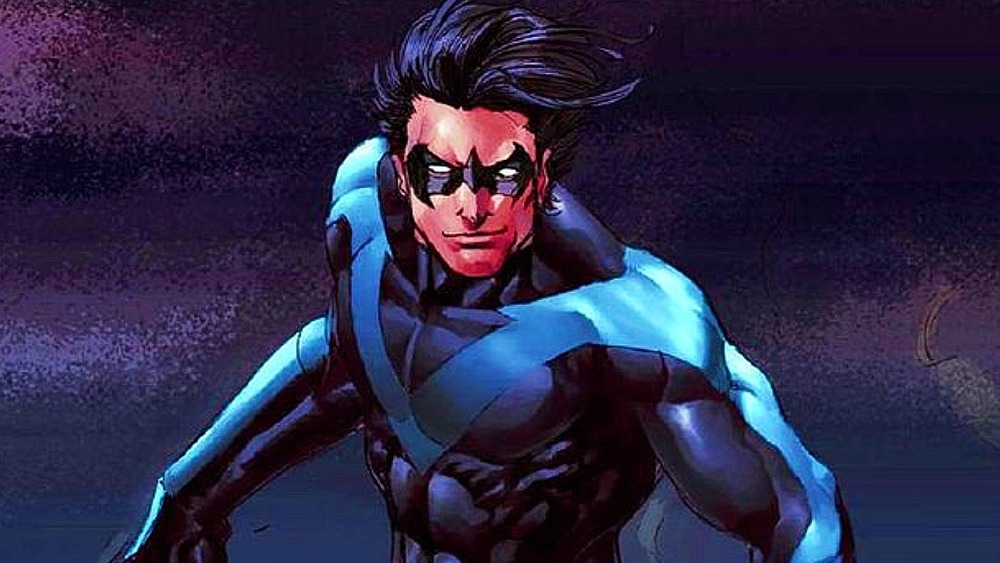Things Only Adults Notice In Batman Forever
If there's any hero who had to grow up too fast, it's Batman. The infamous tragedy of Bruce Wayne's orphaning and the Dark Knight's origin is one of the most poignant in superhero history. And it's a story that gets a whole lot of attention in Joel Schumacher's 1995 take on the Caped Crusader — Batman Forever.
Of course, this crazy superhero flick also involves the madcap antics of the Riddler and a truly psychotic Two-Face, who's really going big into his whole "good side, bad side" shtick. With its wild sets, some over-the-top action scenes, and Jim Carrey's antics as the Riddler, Batman Forever is definitely a movie that appeals to young kids. But there's a lot going on under its black rubber surface that only adults are going to notice. Whether it's psychiatric jargon or thinly veiled innuendo, some elements of Batman Forever can only be properly appreciated after you've grown up.
Only adults will notice the banter between Chase Meridian and Batman
From the beginning, Batman (Val Kilmer) tells Dr. Chase Meridian (Nicole Kidman) that he hasn't had much luck with women, an allusion to his prior entanglements with Vicki Vale and Selina Kyle (known by night as Catwoman) in the previous two Batman films. But Chase is different for a number of reasons. For one thing, rather than lifting her name and likeness from the comics as is typical with the DC hero's supporting characters and romantic interests, Dr. Meridian was created specifically for the film.
This unique character was introduced as a psychiatrist with expertise in (as well as a morbid fascination with, especially when it comes to Bruce) abnormal psychology. Batman, too, has undergone an informal education on the subject by virtue of his many first-hand encounters with deranged criminals, so much of their initial banter hinges on their depiction as intellectual and experiential equals. Of course, their dialogue is still full of double entendres, with Batman asking, "You trying to get under my cape, doctor?"
Chase's first interaction with Batman ranges from the two finishing each other's sentences to her coyly commenting, "Not every girl makes a superhero's night table," when he reveals that he's read her work. Batman initially retreats from Chase's advances in much the same way as she retreats from Bruce's. He shoos her away with comments (which are still quite flirty) like, in response to her swooning over the black rubber of his costume, "Try a fireman, less to take off." The banter between Chase and Batman adds to the tension of a love triangle that actually only includes two people.
The are a whole lot of 'face-offs' in Batman Forever
Though Jim Carrey's animated face, spasmodic mannerisms, and neurotic personality punctuate the film with visual gags, Tommy Lee Jones' Two-Face is a spectacle of a different sort. Through wardrobe and set design, he achieves some pretty dramatic aesthetics throughout the film, and most of the correlations to his dual personality are pretty apparent.
Of course, some people found his Two-Face a bit much. In fact, a lot of film buffs and fans were disappointed with the film as a whole, due to its overall campiness that appears to be an homage to the Caped Crusader of the 1960s. Even Michael Keaton, the previous Batman, passed on returning to the role because he couldn't stand the script. But despite what people say, there are some great visual themes here and there, especially when it comes to Two-Face and his antics.
In the opening helicopter chase sequence, multiple faces or parts of faces are destroyed, just like how Two-Face's own was marred in the accident that made him the villain he is. We see a giant neon eye in the sky (a 3D advertisement for an eye product) taken down, and Gotham's likeness of the Statue of Liberty also gets its face taken out by the helicopter's blades in its final crash. Despite what people thought at the time, these clever little gags add a whole lot of fun to Two-Face's campy bit.
Batman Forever's parallel shots
Part of the reason that Batman and Robin (Chris O'Donnell) make such great partners — and arguably a major factor in Bruce deciding to take on his orphan protégé in the first place — is the Caped Crusader's guilt over the death of the young Dick Grayson's parents. Dick's family, a group of trapeze artists known as the Flying Graysons, had been killed by Two-Face when he attacked a circus production largely attended by Gotham's elite. And the supervillain's whole motive was wreaking havoc until someone revealed Batman's identity.
Bruce's guilt, of course, wasn't localized to the Grayson's deaths alone. Instead, it triggered a traumatic flashback to the demise of Bruce's own parents, revealing that he had, deep down for all those years, blamed himself for that, too.
The camera tells the story of this combined guilt without words. We see Bruce's parents lying face down on the ground in a circle of light in his flashback, and the Graysons land in a similar position after falling from the top of the circus tent. This visual analogy adds to the fact that Bruce empathizes with Dick's experience, and it foreshadows the bond he and Robin eventually share in their partnership against evil.
Adults might notice that ancient Greek awkwardness
Even kids would probably notice the nipples and enlarged codpieces of the Batman and Robin costumes. These design choices drew ire (as well as confusion) from viewers, and they became an infamous leg of the Batsuit's long and controversial journey.
But it wasn't just an afterthought, an oversight, or even a joke. At the time, director Joel Schumacher and his lead sculptor, Jose Fernandez, thought it was an awesome idea that properly took advantage of how far rubber-molding technology had come since the days of Michael Keaton's Batman.
Schumacher explained to Vice that rather than follow in the heavy footsteps of Keaton's large and unwieldy-looking Batsuit, he realized that they had the technological ability, and therefore aesthetic freedom, to make the costumes anatomically correct. So that was the direction in which he pointed Fernandez, drawing inspiration from the statues of ancient Greece. This is something you wouldn't draw a connection to if you weren't an adult — possibly one with a classics degree and a very lenient imagination.
Edward Nygma's delusions and allusions
Without receiving an explanation for the wordplay involved in E. Nygma's name, a lot of kids might not know what an "enigma" is, or at the very least, they would have to ask their parents after watching. But there are more little details about this villain, left unexplained as a proper enigma should be, that only adults would notice.
When Edward Nygma, soon to be the Riddler, is trying to think of a name for his villainous persona, one of the options he considers is "the Puzzler." This is actually the name of a real Batman villain who replaced the Riddler in the 1960s TV show, but it was only for a brief time while the Riddler actor, Frank Gorshin, was caught up in a contract dispute.
However, the Puzzler isn't the only allusion to the past. Nygma also spoofs a famous anti-drug commercial from the '80s, which compares "your brain on drugs" to a frying egg. This little gag goes down when the crazed scientist realizes that his new invention allows him to steal others' brain power, prompting him to quip, "This is my brain on the Box, does anyone else feel like a fried egg?" While kids will totally miss the reference, parents who grew up in the '80s will definitely recognize the parallels to these anti-drug campaigns.
Batman Forever is full of psychological themes and jargon
Most of Batman's nemeses seem a little wacky, and some of them even seem to offer fairly on-the-nose, if over-the-top, representations of specific, diagnosable mental illnesses. Even Batman's entire origin story itself could be seen as a case study in post-traumatic stress disorder. Doctor Chase Meridian in Batman Forever sure seems to think there's something to the psychology of both the heroes and villains who inhabit Gotham City. It's part of what draws her to Batman, in fact. But as she says, "A girl can't live by psychoses alone."
But she does make a living out of psychoses. In fact, her first encounter with Batman involves their discussion of Two-Face's multiple personality disorder (now officially known as dissociative identity disorder). In the office of her psychiatry practice, Bruce Wayne sees a Rorschach test and asks Chase if she has a thing for bats, to which she responds with an explanation of ink blot testing — you see what you want to see, so the more appropriate question is whether Bruce has a thing for bats.
At the end of their meeting, or perhaps to avoid an uncomfortable topic, Bruce says, "Time's up," and Chase responds, "That's usually my line," alluding to the common trope of therapists and psychiatrists cutting off their patients at the end of the billed hour. Hopefully, this isn't a joke that will kids will understand.
Adults will love all the split elements of Two-Face's personality
Two-Face's character simply drips in visual symbolism. In this film, the symbols are usually pretty thinly veiled (from his comically lopsided suit to the yin and yang symbols that decorate his henchmen and other implements of evil). But there are some dichotomies that only adults would catch, unless their children make a habit of attending fancy dinners or gun shows.
Two-Face is constantly attended by two women credited as Sugar (Drew Barrymore) and Spice (Debi Mazar). Their names are pretty self-explanatory. Sugar represents finer, gentler sensibilities and Two-Face's merciful side, while Spice represents deviance, debauchery, and darkness. Sugar and Spice also prepare their employer's food in the film. Sugar's offering of "sparkling champagne, yummy poached salmon with little, itty-bitty quail eggs and a creamy, dreamy lemon soufflé" is much lighter and more sophisticated than Spice's "charred heart of black boar, a side of raw donkey meat, and a Sterno and grain alcohol straight-up."
Sure, kids would know that donkey meat must be a delicacy from the dark side, but they wouldn't know that the "drink" Spice describes is not fit for consumption at all. Sterno alcohol is used for heating and meant only to be burned in its can. These double-sided details carry over into the bad guy's firearms. Two-Face can be seen wielding a stainless steel revolver in one hand (on his unmarred side) and a blued gun in the other. Stainless steel is pure, but blued guns sport a protective coating ... like scar tissue.
Batman Forever is full of one-liners that parents will appreciate
Batman Forever is full of one-liners, especially when the Riddler is around. And as it turns out, a number of these little quips are sayings that only adults — parents, in particular — would use on a day-to-day basis.
At one point, the Riddler says of Two-Face's scarred side, "If you don't stop picking at that, it's never going to heal," which is a note of cautionary advice that parents often offer their children regarding scabs and acne. Similarly, when Riddler knocks his boss out with a coffee pot, he says, "Caffeine will kill ya," which is another phrase that parents repeat to their children in an effort to promote healthier habits.
And on the note of being unhealthy, when detractors say that putting Riddler's new "Box" on TVs will turn people into "zombies," the Riddler responds by joking that's what they said when TV was invented. And he's not wrong! It's still widely believed today that it's healthier to unplug and limit screen time. Speaking of brightly lit distractions, when the Riddler debuts his new light-up question mark jacket, he says that it keeps him safe while jogging at night, which may ring true for protective parents who put reflective pieces on their children's bikes, shoes, and helmets.
Grown-up Batman fans will enjoy the Riddler's puzzles
Throughout Batman Forever, the Riddler keeps Batman on his toes with a series of complicated, well, riddles. And if the style of those brain-teasers sounds familiar, it's probably because you're an adult who makes a habit of attempting the New York Times crossword. As it turns out, Will Shortz, the "Puzzlemaster" himself and the Times crossword editor, is the one who wrote out the Riddler's mysterious little clues.
There's also a classic comics callback to the Riddler's first puzzle in the form of a billboard advertisement. This sign advertises "Criss Cross Laundry," lettered in the style of a crossword puzzle, which is directly reminiscent of the Riddler's first comic book appearance where a similar company called Cross Cleaning Co. used a puzzle billboard as promotional material. Hijacking this sign was how the Riddler's riddles were transmitted when he debuted in Detective Comics #140.
Of course, all this poses a question — how did the Riddler get to be such a genius? Well, one possibility is that he never misses his daily dose of Vitamin B12. Though it's delivered as merely one of many zany comments, the devious villain does say during a game of Battleship (when the coordinates "B12" are called) that it's his favorite vitamin. Adults are much more likely to be familiar with the different types of vitamins (kids would probably avoid that knowledge at all costs), especially the fact that B12 is hypothesized to have a role in improving and preserving brain function, which would certainly serve the Riddler's original stated goal of becoming the cleverest man in Gotham.
Paging Doctor Burton
Tim Burton, who directed the previous two Batman films in 1989 and 1992, was let go from Batman Forever after significant public backlash against the darkness of Batman Returns. Burton was still given a producer credit on the 1995 installment, and despite changing the director, the tone, and even the actor who played Batman, Forever was understood to occur in the same universe as the previous two installments.
In fact, the replacement of Burton as director with Joel Schumacher is the kind of change that only adults might be aware of, based on watching the news or the opening credits or perhaps recognizing stylistic differences between Batman Forever and its predecessors. And for those who grieve the change in direction or mourn what could've been had Burton remained at the helm, there's a small consolation beyond the filmmaker's producer credit. The chief psychiatrist at Arkham Asylum serves as an homage to the ousted director, as Doctor Burton shares Tim Burton's surname, as well as his wacky hairstyle (which children might not be old enough to recognize).
Batman Forever has homages to the Caped Crusader's past
Batman Forever is a movie that loves its nostalgia. Don't believe us? Well, throughout the film, both Batman and Robin make allusions to different versions of their characters from days gone by.
After Dick Grayson becomes determined to join Batman in fighting crime and bringing justice to the corrupt Gotham that took the lives of his parents, he begins brainstorming names for his masked alter ego. At one point, he suggests "Nightwing." This name is actually adopted by Dick Grayson in the comics when he seeks an independent superhero identity separate from Batman.
Then, when Batman and Robin arrive at Two-Face's hideout and find, to their surprise, that the island fortress is made of metal, Robin exclaims, "Holy rusted metal, Batman!" This is an homage to the TV Robin of the '60s who would campily shout things like, "Holy (insert remarkable thing here), Batman!" But it's something of a spoof in Batman Forever, rather than a serious line, because when Batman voices confusion at the interjection, Robin explains that the metal is rusted and full of holes (hole-y, not holy). Still, adults who grew up with '60s Batman would certainly enjoy the moment of nostalgia.
The movie features plenty of musical contributions and references
Similar to how 1989's Batman used plenty of songs written by Prince, Batman Forever features original songs by popular artists, including Seal's "Kiss from a Rose," U2's "Hold Me, Thrill Me, Kiss Me, Kill Me," and Method Man's "The Riddler." And as quite a bit of time has gone by since the film's release, kids today probably won't recognize the artists belting out these tunes, but adults will definitely be familiar with these iconic stars.
However, the film also features plenty of references to ballads from yesteryear. For example, when the Riddler sings his little ditty about "sucking up your IQ, vacuuming your cortex, feeding off your brain," he's parodying a song from the 1935 musical comedy Top Hat entitled "Top Hat, White Tie, and Tails," in which the singer describes "putting on my top hat, tying up my white tie, brushing off my tails."
